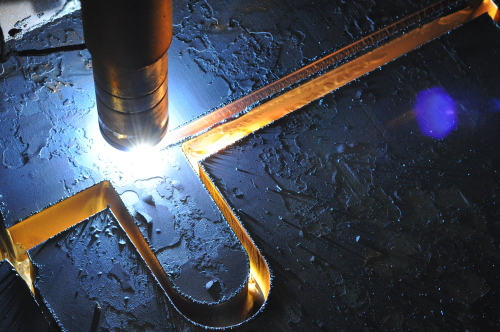Laser Cutting vs. Waterjet Cutting: A Detailed Comparison
April 9, 2024 2:20 pm Leave your thoughts
When it comes to manufacturing and fabrication processes, the choice of cutting technique plays a crucial role in determining the quality and efficiency of the final product. Two popular cutting methods that are widely used in the industry are laser cutting and waterjet cutting. Both techniques offer unique advantages and limitations that cater to different requirements and applications. In this blog, we will provide a detailed comparison of laser cutting and waterjet cutting, exploring their respective strengths, weaknesses, and best applications.
Introduction to Cutting Techniques
Laser cutting is a thermal cutting process that uses a high-powered laser beam to melt, vaporize, or burn through materials. The laser beam is typically generated by a carbon dioxide (CO2) laser, a fiber laser, or a neodymium-doped yttrium aluminum garnet (Nd:YAG) laser. The focused laser beam cuts materials with high precision and speed, making it an ideal choice for intricate and detailed designs.
On the other hand, waterjet cutting is a non-thermal cutting process that uses a high-pressure stream of water mixed with abrasive particles to cut through materials. The abrasive waterjet is generated by a waterjet pump and nozzle, which provides a versatile cutting solution for a wide range of materials, including metals, plastics, composites, and ceramics.
Comparison of Laser and Waterjet Cutting
1. Precision and Accuracy:
Laser cutting offers high precision and accuracy, making it suitable for cutting intricate shapes and designs with tight tolerances. The focused laser beam can cut through materials with minimal kerf width, resulting in precise cuts with clean edges.
Waterjet cutting, on the other hand, may not offer the same level of precision as laser cutting. The abrasive waterjet stream is less precise due to the natural dispersion of the abrasive particles in the water stream. While waterjet cutting can achieve good accuracy, it may not be as precise as laser cutting for intricate and detailed cuts.
2. Material Compatibility:
Laser cutting is suitable for a wide range of materials, including metals, plastics, wood, fabric, and composites. However, laser cutting is particularly well-suited for cutting thin to medium-thickness materials, as the laser beam may struggle to cut through thick materials efficiently.
Waterjet cutting, on the other hand, is highly versatile and can cut through a broader range of materials, including thick metals, stone, glass, and ceramics. The non-thermal nature of waterjet cutting makes it ideal for materials that are sensitive to heat, such as plastics, composites, and heat-treated metals.
3. Cutting Speed and Productivity:
Laser cutting is known for its high cutting speed and productivity, making it a cost-effective solution for mass production and high-volume manufacturing. The focused laser beam can cut through materials swiftly, reducing production lead times and increasing overall efficiency.
Waterjet cutting, while versatile, may not offer the same cutting speed as laser cutting. The abrasive waterjet stream cuts through materials at a slower pace, which can impact production times for high-volume projects. However, waterjet cutting excels in cutting thick materials that may pose challenges for laser cutting.
Advantages and Limitations of Each Method
Laser Cutting:
– Advantages:
– High precision and accuracy
– Fast cutting speed
– Minimal material wastage
– Suitable for intricate designs
– Limitations:
– Limited thickness capabilities
– Can cause heat-affected zones in certain materials
Waterjet Cutting:
– Advantages:
– Versatile cutting capabilities
– Non-thermal process
– Suitable for thick materials
– Minimal environmental impact
– Limitations:
– Slower cutting speed
– Higher operating costs (abrasive consumables)
Best Applications for Each Technique
Laser Cutting:
– Ideal for cutting thin to medium-thickness metals, plastics, and composites
– Suitable for intricate designs and detailed cuts
– Preferred for high-precision applications in industries such as electronics, automotive, and aerospace
Waterjet Cutting:
– Best suited for cutting thick metals, stone, glass, and ceramics
– Ideal for materials that are sensitive to heat, such as plastics and composites
– Versatile cutting solution for a wide range of industries, including architecture, marine, and manufacturing
Conclusion and Recommendations
Both laser cutting and waterjet cutting offer unique advantages and limitations that cater to different cutting requirements and applications. Laser cutting excels in high precision and speed for thin to medium-thickness materials, making it ideal for intricate designs and mass production projects. Waterjet cutting, on the other hand, provides versatility and compatibility with a broader range of materials, particularly thick metals and heat-sensitive materials.
When choosing between laser cutting and waterjet cutting, it is essential to consider the specific requirements of the project, including material thickness, desired precision, and production volume. For projects that require high precision and speed, laser cutting may be the preferred choice. For projects involving thick or heat-sensitive materials, waterjet cutting offers a versatile and efficient cutting solution.
Ultimately, the decision between laser cutting and waterjet cutting should be based on a thorough evaluation of the project requirements, budget considerations, and desired outcomes. By understanding the strengths and limitations of each cutting technique, manufacturers and fabricators can make informed decisions to achieve optimal results in their cutting processes.
Need Steel Fabricators in Hermiston, OR?
NW Metal Fabricators, Inc. is a family-owned business that has been servicing customers in Hermiston, Oregon since 1986. We have more than 100 years of experience in the food-processing industry and specialize in the custom production of storage bins, conveyors, catwalks, handrails, gates, storage tanks, water heater tanks, sanitary piping, steam piping, and trailer truck hitches. NW Metal Fabricators, Inc. is an accredited member of the local Chamber of Commerce. We are a dedicated business where quality always comes first. Our customers know that they can count on us to make sure that their products are hand-crafted to meet their specifications. Contact us today to learn more about what we can do for you!
Categorised in: Water Jet Cutting Services
This post was written by admin
